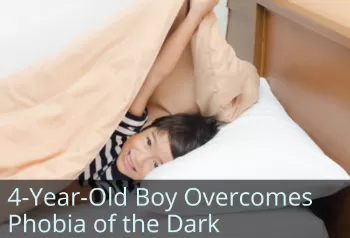Primitive Reflex Integration Case Studies
Innate Movements Help Young Boy Release Fears
Submitted by Maddy A, MOT, OTR/L

| Before | After |
|---|---|
| Phobia of the dark | Can now walk into the bathroom and turn on the light independently |
| Issues with emotional regulation | Able to work through challenges and calm his body and emotions |
Child’s Age: 4 years and 9 months
Child’s challenges include social emotional regulation, self-confidence and esteem, fine visual motor skills highly impacting school readiness, attention, compulsive need to be perfect, selective/picky eating, phobia of the dark, as well as body awareness and coordination. The goals for him are to improve with his reading and letter formation, self-regulation during challenging and directed tasks, self-dressing, increasing his food repertoire, body awareness, and self-confidence in order to complete tasks independently without the help from others or becoming frustrated.
The tools that I used include hand reflex integration as well as fear paralysis reflex.
For the hand reflex integration the goal and intention was to focus on improving distal fine motor movements separate from the wrist, tension on the writing utensil (He writes too lightly) and to improve handwriting as well as attention. Sessions lasted for approximately 10-15 minutes depending on the attention during that session. Each session started with the rhythmic movements [from the Brain and Sensory Foundations course] in order to calm his body and bring attention to his breathing. During the hand reflex integration he demonstrated minimal movements of his fingers and thumbs during reflex stimulation when pressing on the top of the palm and in the middle of the palm. He had difficulty with learning the sequencing of grasp positions so we focused two per session as well as the thumb and little finger isometrics for finger isolation. He was able to complete sequences of 2 however presented with challenges isolating fingers requiring tactile prompts.
Due to difficulty we returned to a supporting repatterning sequences including the puppet crawl with deep breathing. It was amazing to see him work through the challenge and then channel his breathing to calm his body and emotions. He even requested more innate movements specifically #3. For fear paralysis we focused on the active stimulation and fear release tapping points [from the Brain and Sensory Foundations course] to address his phobia of fear of the dark. We completed the tapping in supine so he could see and feel comfortable throughout. We utilized role play with the darkness of the bathroom for our goal and by the third session he was able to walk into the bathroom and turn on the light independently. It was so awesome to see.
[Edited, emphasis added]
*Disclaimer: The activities in the Brain and Sensory Foundations curriculum make use of the natural processes of neuroplasticity and development that are innately wired in the design of human beings to promote maturity and function. These activities appear to calm, organize, and mature the neuro-sensory-motor systems just as we see in the healthy development of human infants. Individual results may vary, and we do not claim to offer a diagnosis or cure for any specific condition or disorder. The Brain and Sensory Foundations activities appear to improve overall functioning resulting in measurable improvements for a range of conditions as demonstrated in over 1800 case studies from participants.

